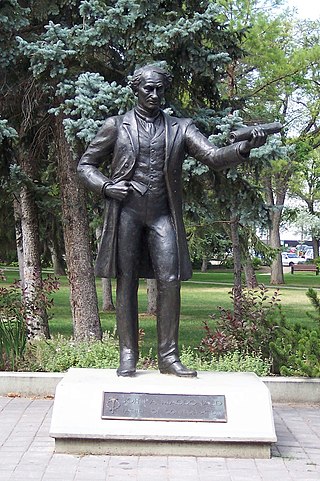
The John A. Macdonald Memorial was a public sculpture in bronze of John A. Macdonald by Sonia de Grandmaison and John Cullen Nugent, formerly located at the south entrance to Victoria Park, Regina, Saskatchewan, Canada. In March 2021, Regina city council voted to remove the statue and it was removed in April 2021.

The Confederate War Memorial was a 65 foot (20 m)-high monument that pays tribute to soldiers and sailors from Texas who served with the Confederate States of America (CSA) during the American Civil War. The monument was dedicated in 1897, following the laying of its cornerstone the previous year. Originally located in Sullivan Park near downtown Dallas, Texas, United States, the monument was relocated in 1961 to the nearby Pioneer Park Cemetery in the Convention Center District, next to the Dallas Convention Center and Pioneer Plaza.

The George Rogers Clark Monument was a historic monument consisting of multiple figures that was formerly located in Monument Square at Charlottesville, Virginia. Erected in November 1921, the monument consisted of seven figures, by the sculptor Robert Ingersoll Aitken, presented on the same pedestal. It was the last in a sequence of four works commissioned from members of the National Sculpture Society by philanthropist Paul Goodloe McIntire during the years 1919 to 1924. The sculpture was added to the National Register of Historic Places in 1997.

Thomas Jonathan Jackson is a historic bronze equestrian statue of Confederate general Stonewall Jackson which was formerly located at Courthouse Historic District of Charlottesville, Virginia and installed in 1921. The statue was sculpted by Charles Keck and was the third of four works commissioned from members of the National Sculpture Society by philanthropist Paul Goodloe McIntire. It was the second of three statues McIntire donated to the city of Charlottesville, which he did over a period of five years from 1919 to 1924. The statue was listed on the National Register of Historic Places in 1997.

The Robert E. Lee Monument was an outdoor bronze equestrian statue of Confederate general Robert E. Lee and his horse Traveller located in Charlottesville, Virginia's Market Street Park in the Charlottesville and Albemarle County Courthouse Historic District. The statue was commissioned in 1917 and dedicated in 1924, and in 1997 was listed on the National Register of Historic Places. It was removed on July 10, 2021, and melted down in 2023.

Meriwether Lewis and William Clark is a historic bronze sculpture of Meriwether Lewis, William Clark, and Sacagawea located at Charlottesville, Virginia. Known as Their First View of the Pacific, it was sculpted by noted artist Charles Keck (1875-1951), and was the first of four commemorative sculptures commissioned from members of the National Sculpture Society by philanthropist Paul Goodloe McIntire. The sculpture was erected in 1919.

The Robert E. Lee Monument in Richmond, Virginia, was the first installation on Monument Avenue in 1890, and would ultimately be the last Confederate monument removed from the site. Before its removal on September 8, 2021, the monument honored Confederate Civil War General Robert E. Lee, depicted on a horse atop a large marble base that stood over 60 feet (18 m) tall. Constructed in France and shipped to Virginia, it remained the largest installation on Monument Avenue for over a century; it was first listed on the National Register of Historic Places in 2007 and the Virginia Landmarks Register in 2006.

The Unite the Right rally was a white supremacist rally that took place in Charlottesville, Virginia, from August 11 to 12, 2017. Marchers included members of the alt-right, neo-Confederates, neo-fascists, white nationalists, neo-Nazis, Klansmen, and far-right militias. Some groups chanted racist and antisemitic slogans and carried weapons, Nazi and neo-Nazi symbols, the Valknut, Confederate battle flags, Deus vult crosses, flags, and other symbols of various past and present antisemitic and anti-Islamic groups. The organizers' stated goals included the unification of the American white nationalist movement and opposing the proposed removal of the statue of General Robert E. Lee from Charlottesville's former Lee Park. The rally sparked a national debate over Confederate iconography, racial violence, and white supremacy. The event had hundreds of participants.

Jason Eric Kessler is an American neo-Nazi, white supremacist, and antisemitic conspiracy theorist. Kessler organized the Unite the Right rally held in Charlottesville, Virginia, on August 11–12, 2017, and the Unite the Right 2 rally held on August 12, 2018.

There are more than 160 Confederate monuments and memorials to the Confederate States of America and associated figures that have been removed from public spaces in the United States, all but five of which have been since 2015. Some have been removed by state and local governments; others have been torn down by protestors.
Payne v. City of Charlottesville is a 2017 lawsuit opposing the removal of Confederate monuments and memorials in Charlottesville, Virginia.
Court Square Park is a public park in Charlottesville, Virginia.
The Charlottesville historic monument controversy is the public discussion on how Charlottesville should respond to protesters who complain that various local monuments are racist. The controversy began before 2016 when protest groups in the community asked the city council for the local removal of Confederate monuments and memorials. Other monuments became part of the controversy, including those of Thomas Jefferson because of his ownership of slaves and those of Lewis and Clark for their advocacy of white colonists over Native Americans.

Christopher Columbus, or simply Columbus, is a 1955 sculpture by Edoardo Alfieri, originally installed outside Columbus, Ohio's City Hall, in the United States. The statue was unveiled in 1955, celebrating Christopher Columbus's voyages to the New World. It was removed in July 2020.












